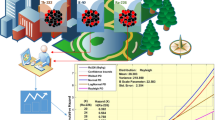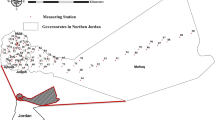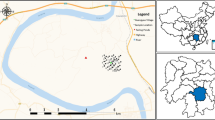Abstract
After the Fukushima Dai-Ichi Nuclear Power Plant (FDNPP) accident, 134Cs and 137Cs were spread widely into the environment. Spatial distribution maps giving radiocesium activities in contaminated soils for post-accident risk modeling were obtained using the Kriging method. We used Generalized extreme-value distribution, Lognormal probability distribution (PDF) and Weibull PDFs for risk assessment of the data. Root mean square error values and coefficient of determination (R2) were calculated for each distribution function. Weibull PDF was found to be more successful in modeling 134Cs and 137Cs activities.
Graphic abstract







Similar content being viewed by others
References
IAEA (2015) The Fukushima Daiichi Accident Report by the Director General
Kinoshita N, Sueki K, Sasa K et al (2011) Assessment of individual radionuclide distributions from the Fukushima nuclear accident covering central-east Japan. Proc Natl Acad Sci U S A 108:19526–19529. https://doi.org/10.1073/pnas.1111724108
TEPCO (2012) List of documents concerning the responsestatus at Fukushima daiichi nuclear power station and Fukushima daini nuclearpower station. In: TEPCO Tokyo Electr. Power Co, Inc
Wu J, Hu X, Ma J et al (2017) Analysis of ground deposition of radionuclides under different wind fields from the Fukushima Daiichi accident. Nat Hazards 87:533–544. https://doi.org/10.1007/s11069-017-2777-7
TEPCO (2011) Estimation of radioactive materials releasedto the atmosphere in the accident of the Fukushima Daiichi Nuclear Power Plant
Minoura K, Yamada T, Hirano S, Sugihara S (2014) Movement of radiocaesium fallout released by the 2011 Fukushima nuclear accident. Nat Hazards 73:1843–1862. https://doi.org/10.1007/s11069-014-1171-y
Jasiulionis R, Rozkov A, Vycinas L (2006) Radionuclides in the ground-level air and deposition in the Ignalina Npp region during 2002–2005
Ashraf MA, Akib S, Maah MJ et al (2014) Cesium-137: radio-chemistry, fate, and transport, remediation, and future concerns. Crit Rev Environ Sci Technol 44:1740–1793. https://doi.org/10.1080/10643389.2013.790753
Characteristics of Caesium-134 and Caesium-137|除染技術情報なび|日本原子力研究開発機構. https://c-navi.jaea.go.jp/en/background/remediation-following-major-radiation-accidents/characteristics-of-caesium-134-and-caesium-137.html. Accessed 2 Jul 2020
Morino Y, Ohara T, Nishizawa M (2011) Atmospheric behavior, deposition, and budget of radioactive materials from the Fukushima Daiichi nuclear power plant in March 2011. Geophys Res Lett 38:1–7. https://doi.org/10.1029/2011GL048689
Chino M, Nakayama H, Nagai H et al (2012) Preliminary estimation of release amounts of 131I and 137Cs accidentally discharged from the fukushima daiichi nuclear power plant into the atmosphere. J Nucl Sci Technol 48:1129–1134. https://doi.org/10.1080/18811248.2011.9711799
Imanaka T, Hayashi G, Endo S (2015) Comparison of the accident process, radioactivity release and ground contamination between Chernobyl and Fukushima-1. J Radiat Res 56:i56–i61. https://doi.org/10.1093/jrr/rrv074
Melgunov MS, Pokhilenko NP, Strakhovenko VD et al (2012) Fallout traces of the Fukushima NPP accident in southern West Siberia (Novosibirsk, Russia). Environ Sci Pollut Res 19:1323–1325. https://doi.org/10.1007/s11356-011-0659-1
Povinec P, Hirose K, Aoyama M (2013) Fukushima accident: radioactivity ımpact on the environment. Elseiver, Amsterdam
Watanabe T, Tsuchiya N, Oura Y et al (2012) Distribution of artificial radionuclides (110mAg, 129mTe, 134Cs, 137Cs) in surface soils from Miyagi Prefecture, northeast Japan, following the 2011 Fukushima Dai-ichi nuclear power plant accident. Geochem J 46:279–285. https://doi.org/10.2343/geochemj.2.0205
Yasunari TJ, Stohl A, Hayano RS et al (2011) Cesium-137 deposition and contamination of Japanese soils due to the Fukushima nuclear accident. Proc Natl Acad Sci U S A 108:19530–19534. https://doi.org/10.1073/pnas.1112058108
Bilici S, Bilici A, Külahcı F (2019) Transport modeling of 137Cs in soil after Fukushima Dai-Ichi Nuclear Power Plant accident by point cumulative semi-variogram method. Environ Earth Sci 78:1–10. https://doi.org/10.1007/s12665-019-8232-1
Bilici S, Külahcı F, Bilici A (2019) Spatial modelling of Cs-137 and Sr-90 fallout after the Fukushima Nuclear Power Plant accident. J Radioanal Nucl Chem 322:431–454. https://doi.org/10.1007/s10967-019-06713-4
Song JH (2018) An assessment on the environmental contamination caused by the Fukushima accident. J Environ Manage 206:846–852. https://doi.org/10.1016/j.jenvman.2017.11.068
Külahci F (2011) A risk analysis model for radioactive wastes. J Hazard Mater 191:349–355. https://doi.org/10.1016/j.jhazmat.2011.04.083
Külahcı F, Bilici A (2019) Advances on identification and animated simulations of radioactivity risk levels after Fukushima Nuclear Power Plant accident (with a data bank): a critical review. J Radioanal Nucl Chem 321:1–30. https://doi.org/10.1007/s10967-019-06559-w
Mikami S, Maeyama T, Hoshide Y et al (2015) Spatial distributions of radionuclides deposited onto ground soil around the Fukushima Dai-ichi Nuclear Power Plant and their temporal change until December 2012. J Environ Radioact 139:320–343. https://doi.org/10.1016/j.jenvrad.2014.09.010
Saito K, Tanihata I, Fujiwara M et al (2015) Detailed deposition density maps constructed by large-scale soil sampling for gamma-ray emitting radioactive nuclides from the Fukushima Dai-ichi Nuclear Power Plant accident. J Environ Radioact 139:308–319. https://doi.org/10.1016/j.jenvrad.2014.02.014
Franic Z, Lokobauer N (1993) 90sr and 137cs in Pilchards from the Adriatic Sea. Arch Ind Hyg Toxicol 44:293–301
Tang TY, Tai JH, Yang YJ (2000) The flow pattern north of Taiwan and the migration of the Kuroshio. Cont Shelf Res 20:349–371. https://doi.org/10.1016/S0278-4343(99)00076-X
Porcelli D, Andersson PS, Baskaran M, Wasserburg GJ (2001) Transport of U- And Th-series nuclides in a Baltic Shield watershed and the Baltic Sea. Geochim Cosmochim Acta 65:2439–2459. https://doi.org/10.1016/S0016-7037(01)00610-X
Wong GTF, Hung CC (2001) Speciation of dissolved iodine: ıntegrating nitrate uptake over time in the oceans. Cont Shelf Res 21:113–128. https://doi.org/10.1016/S0278-4343(00)00086-8
Taira T, Hatoyama Y (2011) Nuclear energy: nationalize the Fukushima Daiichi atomic plant. Nature 480:313–314. https://doi.org/10.1038/480313a
Giannakopoulou F, Haidouti C, Chronopoulou A, Gasparatos D (2007) Sorption behavior of cesium on various soils under different pH levels. J Hazard Mater 149:553–556. https://doi.org/10.1016/j.jhazmat.2007.06.109
U.S. EPA (2015) Particle transport of radionuclides following a radiological incident. EPA/600/R-15/113. U.S. Environmental Protection Agency, Washington, DC
Ratliff K, Mikelonis A, Duffy J (2020) Characterizing cesium sorption in freshwater settings using fluvial sediments and characteristic water chemistries. J Environ Manage 253:109688. https://doi.org/10.1016/j.jenvman.2019.109688
Fernandez B, Salas JD (1999) Return perıod and risk of hydrologic events. I: mathematical formulation. J Hydrol Eng 4:297–307. https://doi.org/10.1061/(ASCE)1084-0699(1999)4:4(297)
Fernandez B, Salas JD (1999) Return period and risk of hydrologic events. II: applicatıons. J Hydrol Eng. https://doi.org/10.1061/(ASCE)1084-0699(1999)4:4(308)
Douglas EM, Vogel RM, Kroll CN (2002) Impact of streamflow persistence on hydrologic design. J Hydrol Eng 7:220. https://doi.org/10.1061/(ASCE)1084-0699
Şen Z (1999) Simple risk calculations in dependent hydrological series. Hydrol Sci J 44:871–878. https://doi.org/10.1080/02626669909492286
Külahci F, Şen Z (2009) Risk assessment of distribution coefficient from 137Cs measurements. Environ Monit Assess 149:363–370. https://doi.org/10.1007/s10661-008-0209-6
Trangmar BB, Yost RS, Uehara G (1985) Application of geostatistics to spatial studies of soil properties. In: Advances in agronomy. Academic Press, pp 45–95
Isaaks EH, Srıvastava RM (1989) Applied geostatistics. Oxford University Press, Oxford
Park S, Fowler JW, Mackulak GT et al (2002) D-optimal sequential experiments for generating a simulation-based cycle time-throughput curve. Oper Res 50:981–990. https://doi.org/10.1287/opre.50.6.981.347
Van Den Boogaart KG, Schaeben H (2002) Kriging of regionalized directions, Axes, and Orientations I. Directions and Axes. Math Geol 34:479–503. https://doi.org/10.1023/A:1019849125046
Rouhani S, Wackernagel H (1990) Multivariate geostatistical approach to space-time data analysis. Water Resour Res 26:585–591. https://doi.org/10.1029/WR026i004p00585
Davis JC (2002) Statistics and data analysis in geology. Wiley, New York
Deutsch C V., Journel AG (1998) GSLIB: geostatistical software library and user’s guide
Şen Z (2009) Spatial modeling principles in earth sciences. Springer, Dordrecht
Leadbetter MR, Lindgren G, Holger R (1983) Extremes and related properties of random sequences and processes. Springer, New York
Coles S (2004) An ıntroduction to statistical modeling of extreme values. Springer, London
Harald C (1962) Random variables and probability distributions. Cambridge University Press, Cambridge
Acknowledgements
This research was funded by Firat University Scientific Research Projects Management Unit (Grant No.: FF.12.25).
Author information
Authors and Affiliations
Corresponding author
Ethics declarations
Conflict of interest
The authors declare that they have no conflict of interest.
Additional information
Publisher's Note
Springer Nature remains neutral with regard to jurisdictional claims in published maps and institutional affiliations.
Rights and permissions
About this article
Cite this article
Bilici, A., Bilici, S. & Külahcı, F. Statistical analysis for 134Cs and 137Cs radioactivity risk levels modeling. J Radioanal Nucl Chem 326, 1047–1064 (2020). https://doi.org/10.1007/s10967-020-07399-9
Received:
Accepted:
Published:
Issue Date:
DOI: https://doi.org/10.1007/s10967-020-07399-9




